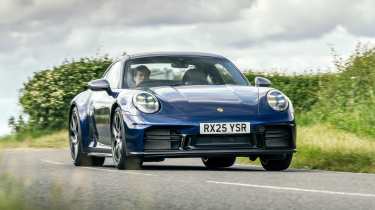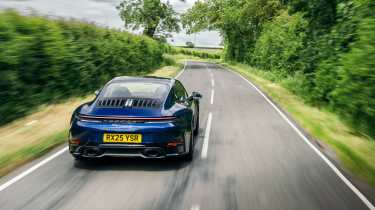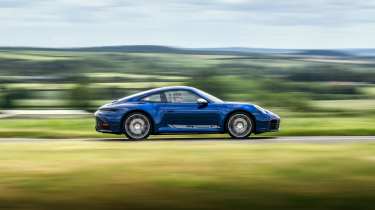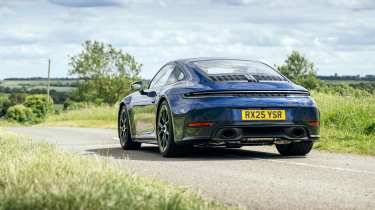Porsche 911 Carrera T (992.2) 2025 review – pure, back-to-basics 992 is one of the best
Against the tide of paddleshift dominance, Porsche’s latest Carrera T proudly waves the manual gearbox flag as part of a more engaging and rewarding 911 experience
Right now the Carrera T is the only mainstream 911 you can buy with a manual gearbox, and Porsche clearly wants everyone to know. Before you’ve even climbed inside you’ll notice the Alibaba-special H-pattern decals on the quarter windows, and once you’ve slid behind the small-diameter, thin-rimmed steering wheel you’ll spot a laminated walnut gearknob sitting proudly between the seats, above an ‘MT’ badge on the centre console. There’s another H-pattern sticker on the dash in case, for some reason, you needed further confirmation that this is in fact a three-pedal 911.
None of this is as cringeworthy as the S/T’s ‘Icons of Cool’ exterior puddle lights, but it’s still a bit try-hard. Ignore the distractions, though, because beneath the tinsel the Carrera T is fundamentally a brilliant, involving sports car – potentially the Goldilocks 911 – and the fact that it’s a manual is worthy of celebration.
The Lotus Emira… and that’s it. That’s the list of current 911 rivals available with a stick, with the likes of the BMW M4, AMG GT and Aston Martin Vantage being paddles-only. The selection is shrinking fast, because most sports car manufacturers are finding it harder to justify the extra development time and costs associated with producing a manual option for the narrow niche of customers who want one new (forums are full of people wanting to buy one used, of course). That even extends to more specialised machinery like the new Morgan Supersport, although there are a few survivors further down the food chain, such as the BMW M2, Ford Mustang and Porsche’s own 718, all of which are available with three pedals.
More reviews
In-depth reviews
- Porsche 911 Carrera GTS T-Hybrid review – the first hybrid 911 is one of the best
- Used Porsche 911 (991, 2011 - 2018) review – should you buy the unloved 911?
Long term tests
Reviews
- New Porsche 911 Turbo S review – McLaren Artura performance with four seats
- RML GT Hypercar review – the Porsche 911 taken to the ultimate extreme
- Used Porsche 911 (997, 2004 - 2012) – the ultimate sweet spot 911
- Porsche 911 Turbo S (992.1, 2020 - 2024) review – Stuttgart’s supercar slayer
- Porsche 911 3.2 Carrera (1984 - 1989) review – flawed but furiously charming
From your initial nudge left and clunk forwards into first, you’ll be very pleased that Porsche has bucked the trend with the Carrera T. It has a lovely shift, heavily sprung across the gate, with a positive, mechanical thunk as the ratios engage, and a progressive clutch action. Straight away there’s more to think about and another element of your driving to finesse compared to a PDK-equipped Carrera, and sweeter rewards as a result. In more technical sports cars – an AMG GT, for example – you sense that a manual would be at odds with their fundamental character, but in a 911, it just feels right.
There’s more to the T than its gearbox though. The badge dates back to 1968, when the original 911 T arrived as a stripped-down, pared-back model to homologate a touring car racer in period. Its weight was modest at 1020kg, power more so at 123bhp, and driving purity was the name of the game. The T was revived for the 991.2 generation in 2017, followed up by a 992 version that in some ways reshaped our view of what is the biggest, most complex and most grown-up 911 to date. A weight-saving diet and detail chassis upgrades brought back some of the sports car grit that was missing in early 992s, and this new Gen 2 version follows much the same formula. But where the outgoing car could be had with PDK for no extra cost, the Gen 2 is manual or nothing, which is more in keeping with the T philosophy, we’d say.
Driver's note
'The carbon bucket seats and stripped out interior give it S/T vibes, but also a fair bit of road noise on the move – a Porsche 992 weak spot generally, but especially in this car.' – evo Deputy Editor James Taylor, who drove the Porsche 911 Carrera T on the road in the UK.
It’s based on the latest – and now PDK-only – Carrera, borrowing that car’s 3-litre twin-turbo flat-six. You get 389bhp and 332lb ft of torque, which sounds weak in the context of the big, bruising 543bhp M4 CS, and especially when you take the £115,400 starting price account (just £7285 less than the CS, and £11,700 more than the base Carrera). But underestimating the T would be a big mistake, because it has a fantastic spread of useable power and hits much harder than you’d expect from the figures.
The motor almost feels naturally aspirated in its response and linear delivery, but there’s still useful muscle in the mid-range that builds to a sweet rasp at the 7500rpm cut-off. It’s a cracking engine, and with a PTV (Porsche Torque Vectoring) diff fitted as standard, the T’s traction is such that you can deploy its maximum from way down low, time after time, with supreme confidence. If you’ve just climbed out of an M4 you might miss the huge swell of turbocharged thrust, but you soon realise that the T is easily quick enough to be exciting on the road, and it probably wouldn’t suit a more boosty, barrel-chested engine. It’s more about nuance than outright power.
Having a manual brings out more of the flat-six’s character too, the revs quivering when you hit the throttle after an upshift and zipping up crisply with every downshift blip (either by your own footwork or the autoblip function). The ratios of the six-speeder are long in typical Porsche style – you can drive up to the national speed limit in second – but, strangely, this doesn’t really come to mind on a fast, flowing drive. Perhaps because the engine has enough flexibility to cover for it, allowing you to short-shift and still carry rapid pace. Whatever the case, the manual dramatically changes how you drive the car, pulling you into the process where a PDK Carrera can feel clinical in how easy it is to pick your way along a road.
With a sports exhaust as standard the T sounds great too, with a slightly sharper edge to its note than a Carrera. That’s because the lightweighting programme includes thinner glass, reduced sound insulation and no rear seats. Along with the manual ’box, these measures take the T’s kerb weight down to 1490kg, which is 30kg lighter than the standard Carrera. Option the £4621 carbon bucket seats and you can trim that further still, to 1478kg – or 1kg lighter than a PDK-equipped GT3. The manual GT3 remains 16kg out of reach.
There’s more edge to the T’s chassis too, which you feel as soon as you get moving. There’s more tension to the ride and you jostle around in the seat over broken roads at low speed, even in the Normal damper setting. It sits 10mm lower on PASM sport suspension with adaptive dampers, with retuned anti-roll bars and a larger, 20/21-inch staggered wheel set-up than a base Carrera. The busier and more connected feel suits the T’s brief to an extent but nudges it towards the more focused end of daily sports cars. Pick up speed, though, and some of the calmness of a standard Carrera comes back, the T staying flat, poised and controlled. Couple this with clean, accurate steering that builds reassuring weight (there’s a more direct steering ratio and specially tuned rear-axle steering as standard) and your confidence doesn’t fade as you sweep into fast corners and carry the momentum you’ve built. Grip is supreme and it can withstand massive commitment in the dry. As in the base Carrera, sometimes you wish there was a bit more to manage, to feel like you’re making a difference, but having three pedals partly makes up for that, keeping your brain, hands and feet more engaged.
At normal speeds you wonder why there’s a Sport damper setting, given how connected the chassis feels in Normal. But drive at pace on a really challenging surface and you occasionally find the limits of control, the weight shifting across the axles more than you might like over bumps under hard cornering loads. Sport tightens this up, and while there’s a firmer edge to the ride, you take this as a trade-off and just get on with it.
Driver's note
'One downside is that, for me, the suspension is very firm. In the softest of the two damper modes, it’s already pretty uncompromising and at times I actually find it more comfortable in the firmer setting: you get a bit more body control without losing all that much ride comfort, given the latter is pretty tough to start with.' – evo Deputy Editor James Taylor, who drove the Porsche 911 Carrera T on the road in the UK.
It may be less wild and acrobatic than an M4, but there’s still real joy to be had in working the T up to its limits and subtly manipulating it, in a way that the best 911s always allow you to do. The grip is such that the changes in attitude are subtle, but you can hold the brakes (which have great feel and power) on the way into corners to help turn-in, and then balance the car on the throttle all the way through. Too much power early in a corner pushes the nose gently wide. Be patient and the T slingshots onto the next straight without wasting a scrap of energy. A combination of aggressive turn-in and full power in the lower gears can pivot the car into a neat slide, the massive 305-width rears still finding fantastic forward drive and regaining grip smoothly. Combine this with the sweet delivery of the flat-six and added action of the manual ’box and you have the makings of a really absorbing 911.
And as long as you can live with the connected ride and noisier cabin the T spec brings, it’s still one you can use every day. The cabin is well built, the ergonomics are spot on and the 992.2’s infotainment system is easy to get along with (even if we miss the gorgeous analogue rev counter of the Gen 1, replaced by fully digital dials here). It’s not an ultra-refined cruiser, though. On smooth roads it’s fine, but on rougher surfaces there’s a constant rumble from those fat rear tyres – a typical 911 trait, made worse by the T’s lack of insulation and rear seats (the latter is a no-cost option to add back in).
Generally though, the T’s added rawness is well judged and gives it a genuine sports car feel where the 992 has sometimes been accused of being too grown up. It’s purer and more exploitable than an AMG GT, more communicative and finely tuned than an M4 CS. And it holds up well against its ancestry. I happened to jump in a standard 996 Carrera not long after a stint in the T and was surprised at how much more I enjoyed driving the more digital, less analogue 992. Not because of its raw speed, but for the precision of its controls, sweeter gearshift and more vocal and exciting engine. Controversial maybe, but a reminder that not everything was better in the old days.
Price and rivals
It seems like every 911 rival has either jumped up in price or changed tack in recent years. And as mentioned, if you’re after a manual alternative to the £115,400 Carrera T, there’s even less choice on offer.
The Lotus Emira is another three-pedal, six-cylinder sports car that you could feasibly use every day, and undercuts the T by almost £20k. Its downsized-supercar styling makes it much more distinctive than the 911, but there's something lacking in the driving experience. It's not as polished as it should be for what is the first brand new Lotus sports car in a long while, lacking the 911's locked-on reassurance and precision. The Lotus's manual gearshift isn't as sweet, either. With that said, we haven't driven the tweaked V6 SE model, which could unlock the magic that has so far been missing.
For £10k less than the Carrera T, you can bag a Mercedes-AMG GT43, but with a four-cylinder engine and auto ‘box, it’s not as pure a driver’s car. Aston Martin’s Vantage, meanwhile, has moved up a category in its latest generation, costing from £165k. Closer to the T’s price point is the £122,685 BMW M4 CS. While not offered with a stick, the M4 is sharp, exciting and more wild in character than the Porsche, if lacking its approachability and fine control.
Venture into the classifieds and £115k will buy you some very serious metal. Manual 991.2 GT3s are just about within reach, and if you’re not dead-set on having a stick, full-blown supercars (and eCoty winners) like the McLaren 720S and Maserati MC20 are available.





